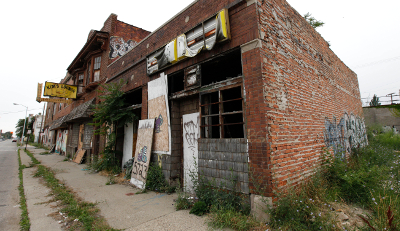The System Killing Detroit
by Li Onesto | December 16, 2013 | Revolution Newspaper | revcom.us
When a judge ruled on December 3 that Detroit could not pay its debts, the place best known for making cars and soul music became the largest U.S. city to declare bankruptcy. The judge also decided that as part of restructuring its debt, Detroit could cut pensions, affecting some 23,000 retired municipal workers.
The judge declared that with his ruling, Detroit now has an "opportunity for a fresh start." But the people living in Detroit are already suffering from unemployment, poverty, cutbacks, and lack of social services, and all signs point to things only getting worse.
In 1950, Detroit was the fifth largest city in the U.S., with 1.85 million people. Today Detroit's population of only 700,000 continues to shrink. Eighty-five percent of the people living here are African-American. An estimated 1 in 3 people live in poverty with more than half the children impoverished. This is the poorest large city in America. Many neighborhoods have simply been abandoned by the government. Anyone driving through large parts of Detroit can testify to the stark landscape, how it brings to mind an almost post-war scenario: whole blocks with only one or two occupied houses, vast areas where no one lives—vacant, overgrown with weeds, big school buildings with broken windows, empty and decaying.
The city estimates 78,000 "abandoned and blighted" structures, roughly one-fifth of Detroit's housing in an area of 139 square miles—big enough to fit Manhattan, Boston and San Francisco. Twenty-two percent of the city's industrial zoned land is vacant; 36 percent of commercial land is vacant. For every 100 residents, there are only 27 jobs. Official unemployment is 18 percent—twice the state level. Among Black people, especially the youth, official unemployment is over 30 percent, but even city officials say it is actually closer to 50 percent.
Many residents don't even have access to basic things needed to live day-to-day. People wait two to three hours for the bus. There are no large chain grocery stores within city limits. More than half the parks have closed in the last five years. Forty percent of the streetlights don't work. Only a third of the city ambulances function. In large parts of the city many public schools have shut down and there are no essential services like transportation, fresh water, gas, electricity, and emergency services.
Speaking to the current conditions in the city, one resident said, "As an oppressed 24-year-old Black woman, sometimes I feel like I am an endangered species."
All kinds of "explanations" are being given for the financial collapse of Detroit. Some touch on part of the picture, talking about the loss of tens of thousands of jobs when the auto plants shut down. Most lead in the wrong direction—pointing to things like corruption, incompetent officials, and "greedy corporations." And racists are spewing all kinds of poison which in essence says that this just goes to show how a city "run by Black people is bound to fail."
But to really understand what's going on in Detroit today, you have to look back at how the economic and political workings of capitalism have shaped this city for many decades.
There are intersecting dynamics that have come to a head here, resulting in an extreme economic, political and social crisis in Detroit. There is the dynamic of the intense and systematic national oppression that Black people have faced since they began coming to the city from the South in the early 1900s. There are the major changes and transformations associated with globalization that have impacted the auto industry—the traditional heart of employment and a primary source of city tax revenues. And there are the effects of the global-economic crisis of 2008 and its continuing fallout on the finances of cities like Detroit.
This is obviously a big topic. But these are the things that need to be explored if one is to understand the situation in Detroit. The following is a beginning outline of these points.
Apartheid Detroit
You can't discuss the crisis in Detroit without talking about the fact that this is a city that today is more than 80 percent Black, and about the oppression of African-Americans since they began coming to Detroit almost 100 years ago.
The Great Migration of Black people from the South in the early 1900s profoundly changed the economy and social structure of many northern cities, including Detroit. When Detroit became the center of the automobile industry tens of thousands came looking for jobs, including Black people from the South. In 1915 fewer than 6,000 Black people lived in Detroit; five years later there were 40,000 African Americans in the city. The total population nearly doubled every 10 years for the next four decades, making it the fastest growing city in the world. By 1950 nearly two million people lived in Detroit, more than 16 percent of them African Americans.
Black people came looking for a better life—not only for employment, but also for an escape from the humiliation of Jim Crow and the constant threat of the lynching tree. But it is no exaggeration to say that what they ended up with was an apartheid-like set-up backed by laws, police and vigilante violence—all of which echoes up through today.
The Ku Klux Klan sent their first recruiter to Detroit in 1921 and by 1924 had signed up 35,000 members.
Black people in Detroit, as an unofficial rule, were only allowed to live in a 60-square-block area on the city's lower east side that became known as "Black Bottom." And if they tried to move into a white neighborhood, they were met with violence.
In 1925, a Black doctor, Ossian Sweet, and his family moved into a home on Detroit's east side. A mob of hundreds of angry whites gathered in front of the house, throwing rocks and shouting racist threats. Someone from the house fired into the crowd, injuring one man and killing another. The person accused of this was acquitted, but the incident demonstrated the danger Black people faced if they tried to resist the systematic discrimination they faced in housing—as well as in other things such as employment and education.
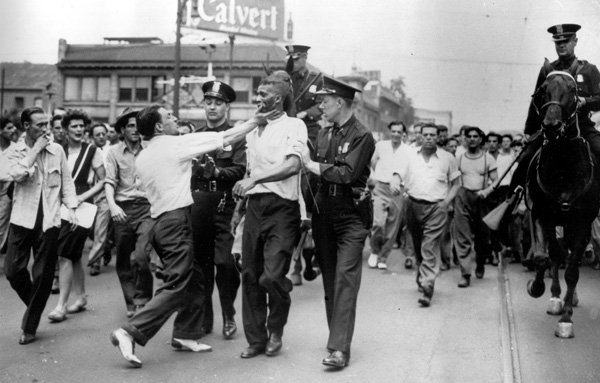
Detroit, 1943: A white racist mob attacks a Black man who had already been shot by someone in the mob during anti-Black rioting. Photo: AP
White real estate agents refused to show Black families properties outside the Black Bottom neighborhood. And then, starting in 1924, associations of real estate agents actually barred members from selling houses in white neighborhoods to Black customers and imposed sanctions on those who broke this rule. Banks and insurance companies also restricted access to home and business mortgages as well as home improvement loans for Black people in Detroit. (See Arc of Justice, by Kevin Boyle, 2004, p.145)
After World War 2, the development of suburbanism was a major feature of the U.S. landscape and was underwritten and fostered through conscious government policies. In Detroit this contributed to further racial segregation. As Thomas J. Sugrue wrote:
"New expressways accelerated the process of suburbanization. New housing developments for both blue and white collar workers sprung up virtually overnight in what had been rural areas on the outskirts of the metropolis. The largest blue-collar suburb (and soon the third largest municipality in the state) was Warren. A community of truck farms before World War II, by 1960, it was home to over 150,000 people who lived on streets lined with block after block of little ranch houses and Cape Cods. Warren and suburban Macomb County (of which it was a part) became a Mecca for blue-collar whites fleeing the city. White-collar workers also filled up new subdivisions as quickly as they could be built in the city's northern and western suburbs. Wetlands and farmlands alike became seas of green lawns, divided by ribbons of tarmac. By 1960, more whites in metropolitan Detroit lived in the suburbs than in the city (though very few blacks did—because real estate agents refused to sell to them and they faced intense hostility and often violence when they tried to cross suburban boundaries)." (From Motor City to Motor Metropolis: How the Automobile Industry Reshaped Urban America)
Black people were prevented from buying affordable houses in these all-white suburbs. Meanwhile, whites benefited from big homeownership subsidies through the Federal Housing Administration and the Veterans Administration.
In 1945 the U.S. Supreme Court ruled on a case in which a Black family had bought a house with a "restrictive covenant" that barred "people of the Negro or Mongolian Race" from occupying the property. After the Court ruled that such a covenant could not be enforced by the state, real estate brokers and developers in Detroit encouraged the formation of "neighborhood improvement associations" to enforce the longstanding rules of segregation.
Between 1943 and 1965, Detroit whites founded at least 192 neighborhood organizations throughout the city. Their rhetoric echoed the KKK—referring to the "white race" and speaking of "we the white people." (See The Origins of the Urban Crisis—Race and Inequality in Postwar Detroit, by Thomas J. Sugrue, 1996, p. 212)
In the years after World War 2, such groups instigated over 200 incidents of harassment, mass demonstration, picketing, effigy burning, window breaking, arson, vandalism, and physical attacks against Black homeowners to try to keep them out of white neighborhoods. (See Heather Ann Thompson, Whose Detroit? Politics, Labor, and Race in a Modern American City, 2001, p.14)
This continued for decades. For example, Sugrue describes what happened when Easby Wilson, a Black auto worker, tried to move into a predominantly white neighborhood in 1955. This incident was typical during this time:
"White members of the Cadillac Improvement Association approached the Wilsons and demanded that they sell the house. That evening, someone threw a stone through the bathroom window. For two straight nights, the phone rang with angry, anonymous calls. On Friday, after dinner, a small crowd gathered on Riopelle Street in front of the Wilsons' house. They were soon joined by more than four hundred picketing and chanting whites, summoned by young boys who rode their bikes up and down the street, blowing whistles. The crowd drew together a cross-section of neighborhood residents: as Mrs. Wilson reported, 'it was children; it was old people; it was teen-agers; in fact all ages were there.' Demonstrators screamed epithets. 'You'd better go back where you belong!' shouted an angry neighbor. A rock shattered the dining room window." (Sugrue, p. 232)
The attacks continued over the next two months, sometimes while police sat in their cars nearby. Eventually the Wilsons moved and years later, in 1960, only 2.9 percent of the neighborhood's residents were Black.
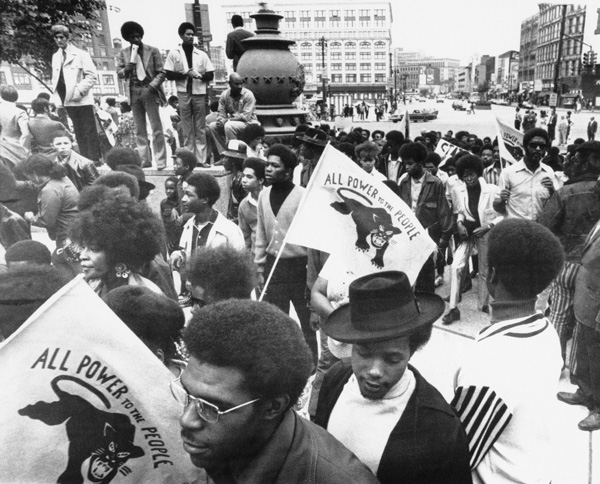
Detroit, September, 1971: After two Black youth were shot by Detroit police, and on top of the murder of revolutonary prisoner George Jackson and the Attica prison rebellion, thousands of people held a "State of Emergency" rally in downtown Detroit. Photo: AP
In 1963, white neighborhood groups proposed a "Homeowners' Rights Ordinance" to preserve their "right" to segregate neighborhoods and their right to discriminate in real estate sales. After this was defeated, there were 25 cross burnings in 1965 alone.
Slow Genocide Today
So what about after the Civil Rights Movement? And what about today? Do Black people in Detroit still face an apartheid-like situation?
In 1986, then mayor of Detroit, Coleman Young, said something that shines a light not only on the situation then, but what exists even more intensely today:
Controversy over a law in Dearborn, a white suburb Detroit, that barred "outsiders" from its parks had brought to the surface intense racial tension. In the midst of all this, Young denounced more restrictive gun control measures that had been proposed for Detroit, including collecting guns from the public. He said:
''I'll be damned if I'm going to let them collect guns in the city of Detroit while we're surrounded by hostile suburbs and the whole rest of the state who have guns, where you have vigilantes, practicing Ku Klux Klan in the wilderness with automatic weapons.''
Attorneys for Dearborn argued the law was not discriminatory in intent because it had been approved by voters, "whose motivation could not be determined." And when it came right down to it, they argued that Dearborn residents basically just had the right to say who could use their parks—just like they had the right to keep Black people from moving into their neighborhoods or going to their schools.
Other suburbs around Detroit had been able to avoid the charges of open discrimination by simply building physical barricades and requiring residents to show ID cards to enter (like gated communities). In the suburb of Grosse Pointe Park officials proposed cul-de-sacs and walls—that supposedly were to ease traffic and prevent flooding. But clearly these were a way to "keep out Black people," to enforce what amounted to apartheid rules.
Think about this situation 27 years ago and then think about Amerikkka today:
2010: Detroit police raid a house in the middle of the night and kill seven-year-old Aiyana Stanley-Jones, sleeping on the couch with her grandmother, and now, in 2013, a judge declares a mistrial in the trial of the only cop to be charged for the murder. 2012: Trayvon Martin is gunned down by a racist vigilante for the "crime" of being young and Black—and the system lets the killer go free. 2013: a 19-year-old Black woman, Renisha McBride, gets in a car accident and looks for help in the white Detroit suburb of Dearborn Heights, but instead of finding aid is treated like a suspect, shot in the head and killed.
But it is not just this, and it is not just Detroit. There is what Carl Dix of the Revolutionary Communist Party, USA has called a slow genocide of Black people in this country—that can easily become a fast genocide.
You've got some 2.3 million people in prison, the majority Black and Latino, subjected to horrible conditions, many doing long sentences for minor drug crimes. You've got a pipeline leading to this warehousing in prison that includes official policies like gang injunctions, the NYPD's stop-and-frisk and inner-city schools that treat a whole generation of youth like potential criminals—guilty until proven innocent, if they can survive to prove their innocence. And there are tens of millions of Black people, who when they get out of prison are then branded with a badge of deprivation and shame, denied jobs, access to public housing, government benefits, the right to vote and more. All this due to the conscious policies of the U.S. ruling class.
As Carl Dix says, "If things are allowed to continue on this trajectory, the reality of millions of the oppressed penned up in the ghettos and barrios without opportunity or hope will intensify. Going in and out of jail will remain a rite of passage for millions of oppressed youth, many of whom already look to their immediate future and can see nothing more than prison or death. This is slow genocide and, given the sharp divisions in the ruling class and the building up and unleashing of outright fascist forces, it could easily become fast genocide."
Indeed, the kind of vigilantes and KKKers with automatic weapons who were practicing in the Detroit suburbs in the 1980s are alive and active in the USA today. Just check out the activity and rhetoric of the NRA. But even more significantly, there is a section of the ruling class that represents a rightwing, fascistic program that gives ideological leadership, backing, and encouragement to the ground soldiers who are clutching their guns in the suburbs and doing "survivalist training" in the woods. Just listen to Tea Party leaders like Texas Senator Ted Cruz who openly praised former North Carolina Senator Jesse Helms, who was a racist, woman-hating, gay-hating, reactionary fascist.
Dynamics of Capitalism
At one point Detroit was a place where you could come into town, walk to a factory door and you might get a job on the spot. At its peak the River Rouge auto plant alone employed 90,000 workers. This was a city where for many decades Black people could get a relatively good-paying job—even if it was lower-paying and worse than what white workers got.
But the number of manufacturing jobs in Detroit fell from 296,000 in 1950 to just 27,000 in 2011. Today there are only two auto factories left in Detroit, employing fewer than 10,000 workers. And other businesses that thrived off the auto industry, like restaurants, parts suppliers and financial services have also suffered. In 2009 the unemployment rate in Detroit peaked at close to 25 percent. Today it's close to 18 percent. For the youth, it's more than 50 percent. So what happened?
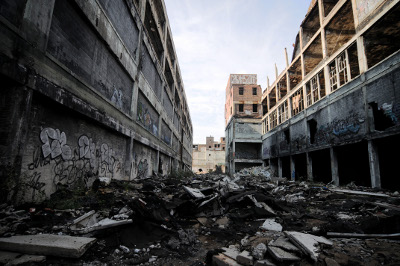
Abandoned Packard Plant on Detroit's east side. Photo: AP
Almost all of the big auto plants in Detroit eventually closed down because it was more profitable to move these jobs—first to rural areas in the U.S., then across the border to Mexico, and then overseas to places like Thailand, Indonesia, and Vietnam. This is the dynamics of capitalism, where different capitalists are locked in rivalry and competition with each other—always searching for the highest profit, and therefore looking for cheaper sources of labor, cheaper ways of producing profit.
This law of capitalism led to so many jobs leaving Detroit, and then more particularly, over the last 15 or so years, U.S. imperialism has forged a globally integrated cheap-labor manufacturing economy with huge labor reserves from China, India, and other parts of the Third World. And these larger workings of global capitalism-imperialism have deeply impacted Detroit as well, leading to further de-industrialization and loss of jobs. In 1992 the big Chrysler plant moved, and overnight 4,500 people were left unemployed.
For Black people, getting a job in Detroit has always meant having to penetrate a thick blanket of racial discrimination—even if this was a city where lots of Black people could get not only factory jobs but also jobs as city employees and some could even make it into the midde class.
Black workers, as Thomas Sugrue puts it, got "the meanest and dirtiest jobs" and sometimes they were simply denied jobs outright. A Black worker would respond to a job posting and be told the job was already taken, even though it was not. Blacks were not allowed to apply for certain types of highly skilled jobs. Sugrue notes, "Labor markets were also structured by workers' culture, attitudes, customs, and work rules. When workers formed a sense of 'brotherhood' on the shop floor, they often defined it through the pratice of racial and gender exclusion." And if anyone is wondering what "a sense of brotherhood" meant, there is this story: In 1943, the Packard Motor Car Company promoted three Black men to work next to whites on their assembly lines. In response, 25,000 whites walked off the job. This was three weeks before violence broke out between Blacks and whites in which, over the course of three days, 34 people were killed. Twenty-five of those who died were Black, 17 of them killed by the police. Over 400 were injured in the three days.
Before the state of Michigan passed a Fair Employment Practices Law in 1955, private employment agencies regularly listed racial preferences in job listings.
A woman described what it was like to work in the auto plants in the early 1970s, following the 1967 Detroit Rebellion when Black people rose up for five days against their oppressive conditions of life. She said the factories hired many Black workers, including people without much education, and later more women began to be hired as well. Then hiring essentially stopped for about 10 years and when it picked up again the hiring was noticeably different. She said it was more white—50 percent as opposed to around 20 percent white in the 1970s, people with education and longer work experience. She herself at one point worked in a printing company in downtown Detroit and said, "They did not advertise job openings in the Detroit papers. Instead, they would place ads for job openings in the papers for the all-white far northern or western suburbs." She also recalled how one Black autoworker tried to apply to one of the plants and even though he had been in the union for many years, was required to take a psychological profile test that included questions about how he felt about the government.
Bailout for Imperialism
On top of the built-in dynamics of capitalism, bleeding the city of jobs, the financial crisis/recession, starting in 2007 resulted in the further de-industrialization of Detroit, along with many other cities. Then there was the sudden jolt in 2009 when the U.S. government bailed out the U.S. auto industry.
In January 2009, the federal government used $25 billion to rescue two of the Big Three auto companies, General Motors and Chrysler. Some might think the U.S. government bailout of the U.S. auto industry would have helped Detroit. But again, the anarchy of capitalism—the laws dictating how things work under this system, along with conscious policies framed to a great degree by Detroit being an overwhelmingly Black city—led to a situation where a relative "recovery" of the U.S. auto industry did NOT mean a "recovery" for Detroit, but instead meant utter bankruptcy.
The days where the success of the U.S. auto industry is tied up with the health and fate of Detroit have ended. And this too is because of the larger, global dynamics of capitalism-imperialism.
There has been an increasing "disconnect" in which Detroit has been disproportionately dependent on the auto industry. But the forces determining change in the U.S. auto industry are coming from the larger world arena, not by what is happening in Detroit. Indeed, the 2009 restructuring and bailout of the auto industry has been calibrated not on the needs of Detroit, but on the overall needs of U.S. imperialism and global competitiveness.
To begin with, the decision by the U.S. government to bail out the U.S. auto industry was based on the larger needs of U.S. imperialism.
The effect of this bailout has been a "leaner and meaner" industry achieved through the shutting down of plants, layoffs, decreased wages, cuts in workers' benefits, and a two-tier wage system for auto workers where new workers are given half the wages of previously hired workers. And it has meant moving operations out of Detroit to countries like China where costs are lower and production is therefore more profitable. For example, GM increased its manufacturing capacity in China by 55 percent since the 2009 bailout.
The 2009 bailout helped save what little industry still remains in the city—two manufacturing plants and General Motors' world headquarters. But this is also not just about the loss of jobs. It also has to do with the tax revenue all this provided to the city of Detroit.
The basic rule of capitalism, of "profit in command," also applies in terms of taxes, pensions and what the city government has and has not been able to do in the face of this crisis.
In his talk, "Why We're in the Situation We're In Today..." Bob Avakian talks about how some people pose the question, why can't the government identify social needs, get revenue and apply that to the problem?
The fact is government can get money from borrowing, but that has to be repaid with interest, so that doesn't generate more money. The government can sell bonds—but those too usually have to be repaid with interest. So ultimately in order to raise revenue that is larger than what it already has, the government has to do it through taxes. It does this both through taxing private citizens and also through taxing corporations.
Under capitalism, this amount of taxes is going to depend on the profitability of capital investment. So when the auto industry was huge and doing well in Detroit, the revenues to the city from the Big Three auto companies, as well as all the other companies and services associated with the auto industry, were relatively large—at least large enough to sustain minimal, if not adequate, social services and the city's basic infrastructure (like water, electricity and public transportation) that people need. The fact that tens of thousands of peope in Detroit were working meant that they were all paying taxes. But as all this has fallen apart—as the auto industry has left the city, as the jobs have left, as hundreds of thousands of people have left the city, this has had a huge negative impact on the city's ability to generate revenue. As Bob Avakian points out, even the limits and the context and the confines within which the government can address social needs in an ultimate and fundamental sense, depends on the profitability of capitalism in an overall sense.
So now there is a situation where people living in Detroit have no jobs, the city isn't providing them with basic services, and Detroit is literally decaying before people's eyes.
And what has this system done in the face of this dire situation for the people?
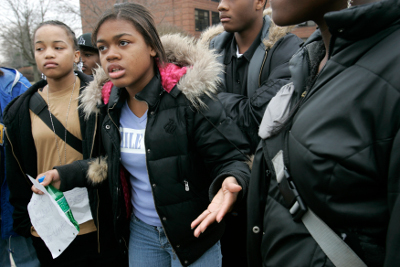
Protest by high school students in Detroit over chronic shortage of books, poor sanitation and a uniform requirement, 2006. Police arrested 32 students. Photo: AP
Those who rule over this system haven't declared an emergency and said we have to do something right away to help people out. In fact just the opposite has happened. People have been hit with even MORE hardship with cutbacks in education, health care, social services and basic necessities of life. Thousands of people who have been working all their life for the city government, people who counted on retirement with a pension they could live on, are now facing severe cuts in their pensions that will have a devastating impact on their ability to survive. And the bankruptcy ruling by the judge giving Detroit the right to cut people's pensions was also written as a precedent for city and state governments across the country. In fact, only hours later, the Illinois legislature voted in favor of a pension "reform" that drastically cuts the retirement income of Illinois state workers.
*****
The crisis in Detroit—the dire situation for the people living there and the system's "solution"– is further exposure of the fact that capitalism cannot, by its very nature, meet the needs of the people.
Capitalism is insane, inhumane and viciously exploitative. While the rulers and defenders of the USA crow about "democracy" and the "land of the free," this system destroys the lives and spirits of millions of people here around the world on a daily, hourly pace. Its very foundations have been intertwined since the beginning, with the enslavement of African people and the continuing systematic oppression of African-Americans. And all this has come together like an economic/political/ideological hurricane that has left the people of Detroit suffering, and many of the Black people of Detroit who make up most of the city, living in conditions that have much in common with a South African bantustan under apartheid.
The financial collapse in Detroit was not the result, fundamentally, of the greed of corporations, the corruption of officials, or the ineptitude of politicians. The "dying" of the city—with its shrinking population, abandoned buildings, lack of basic services, and increasingly desperately poor people—is not the result of "bad decisions" and "lack of will" on the part of government or citizens. All this is due to the playing out of the economic, political and social dynamics of this system of capitalism that have been going on in Detroit for decades. All this is NOT something that this system can "fix." Cities all across the U.S. are right behind Detroit, facing similar situations because the same dynamics of capitalism intersecting with the oppression of Black and Latino people (in many cases) have been and will continue to be at work. All this is yet another example of why we need a whole new system, not based on profit, but on the needs of people, with the goal of emancipating all of humanity.
If you like this article, subscribe, donate to and sustain Revolution newspaper.

